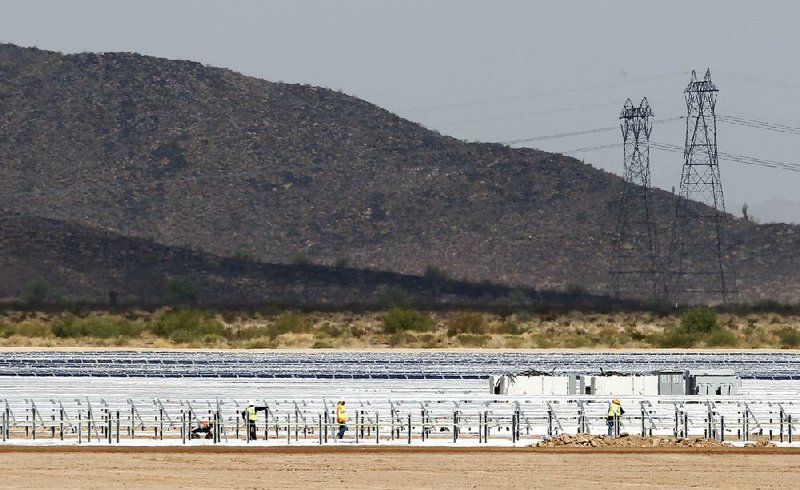ALBUQUERQUE, N.M. — In the open expanses of the American Southwest where heat waves distort the landscape, there’s a huge untapped source of energy that could meet the nation’s growing needs.
But only if developers can get it out of the desert, experts say.
Even as renewable power projects get a boost from the federal government, a lack of transmission lines prevent states such as New Mexico - where the sun shines more than 300 days a year - from converting the obvious potential into real watts that can charge smart phones and run air conditioners thousands of miles away.
Aside from Phoenix, the nation’s sixth-largest city, and Las Vegas, which glows around the clock, the region’s rural stretches - the ideal places for acres of solar panels - have few energy demands. And sending solar power from there to population centers isn’t as simple as loading coal into boxcars and shipping it cross country.
“We have incredible renewable energy resources,” U.S. Energy Secretary Steven Chu said during a visit earlier this year to a solar research lab in New Mexico. “The bad news is they’re where there are not many people. We need a distribution system that can accommodate that.”
Transmission lines are key to developing the region’s solar resources. The problem is existing lines are maxing out, especially as the push intensifies to bring online more renewable energy. Building new lines can take years or even decades of cutting through a tangle of bureaucracy.
Spanning some 200,000 miles, much of the nation’s existing transmission system is aging and will need replacement before 2030, according to preliminary findings of a new Department of Energy study on transmission congestion.
President Barack Obama reminded the nation during the Democratic National Convention that renewable power sources will play a key role in his “all of the above” energy plan. And nearly 5 gigawatts of solar and wind projects - enough juice to run about 3 million homes - were fast-tracked this summer by the federal government.
The Obama administration has also sped up permitting and construction of seven proposed transmission projects in 12 states, but industry experts say reaching into rural areas to tap more renewable resources remains a big hurdle.
Transmission gridlock is looming on the horizon in sunny Arizona, where the state’s transmission capacity would be overloaded by just half of the proposed projects currently in the works. In the Northeast, wind generation has already been curtailed because of a lack of transmission capacity, according to Energy Department researchers.
Utilities such as PacifiCorp., which serves more than 1.7 million customers in six Western states, are already pouring billions of dollars into transmission projects.
Hundreds of miles of lines are planned from Wyoming south to New Mexico and west to Arizona and Nevada, where nearly 7,500 megawatts of renewable energy requests are already in the queue.
By 2015, the industry nationwide is expected to spend around $66 billion on improving transmission reliability and building capacity, according to the Edison Electric Institute, an association of electric companies. But more would be needed to meet all of the nation’s needs.
In New Mexico, there were 18 utility-scale solar projects in the pipeline during the last fiscal year compared to none in 2010. But major transmission proposals that would crisscross the state are still in the permitting phase.
Some progress has been made in the last two years, but the lofty goals set years ago by then-Democratic Gov.Bill Richardson to develop megaprojects and make New Mexico the “solar capital” of the U.S. have yet to be realized. Part of it has to do with competition.
“There are projects being developed in Arizona. There are projects being developed in California. And the states that have an interest in developing solar tend to have their own resources,” said Jason Marks, a New Mexico public regulation commissioner.
“They’re wanting to keep the money that they’re spending in their own economies,” he added.
Making solar power into a reliable export to populated states is “the biggest game in town,” said Abbas Ghassemi, an energy expert at New Mexico State University.
“For most of these states, they’re looking at it for economic development and job creation,” Ghassemi said, underscoring the reasons why solutions such as cost incentives and utility quotas haven’t helped states like New Mexico catch up to California and New Jersey, an unlikely solar leader.
Arizona Gov. Jan Brewer recently said the success of the industry is a key asset to her state’s economy. Her comments came after learning Arizona moved up in the national rankings, becoming second only to California for the number of photovoltaic panels installed at homes and businesses during the second quarter this year.
Nationally, the Solar Energy Industries Association reported more than 20 utility-scale photovoltaic projects were completed during the second quarter, marking the largest quarter ever for solar panel installations.
At the National Renewable Energy Laboratory in Colorado, scientists have modeled what the U.S. would look like in 2050, and they say it’s possible for renewable energy to make up 80 percent of the electricity generated, even with existing technologies.
Whether that comes to pass will depend on the price of technology, transmission capacity and policies and regulations that encourage renewable energy development.
With more polls showing Americans favoring renewable energy and politicians looking desperately for ways to boost the economy, Adam Browning, executive director of the California-based nonprofit Voter Solar Initiative, said the will seems to be shifting.
“Renewables provide a powerful solution that’s really about tapping into great American values of self-reliance, of technology mastery, of creating new industries that put people to work,” he said. “I really feel there’s a great political narrative to this.” Information for this article was contributed by Felicia Fonseca of The Associated Press.
Business, Pages 21 on 09/24/2012

